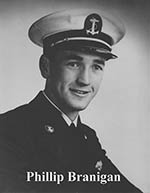Phillip George Branigan
Branigan was born in New York City but went to Teaneck High and graduated in 1940. He was a talented singer and bass fiddler. An avid reader, he had ambitions of becoming a botanist according to his yearbook.
When war broke out, Branigan tried to enlist but was denied due to eardrum issues suffered in childhood. Instead he enrolled in Kings Point to become a sailor.
As a midshipman cadet, only 20 years old, he volunteered to sail on the SS James McKay which carried vital supplies to Britain. His ship was part of convoy HX-217 which became scattered due to violent weather. The James McKay fell behind and was easy prey for U-boat 600 which sank it with several torpedoes. All of the crew were lost when the McKay sank some 425 miles south of Iceland.
WWII Scrapbook
High School Yearbook
Ancestry.com
- 1930 United States Federal Census about Philip Branigan
- 1920 United States Federal Census about George Frazer (grandfather)
- New York, NY, Marriage Indexes 1866-1937 about Patrick Branigan & Dorothy A Frazer (parents of Philip Branigan)
- 1930 United States Federal Census about Patrick J. Brannigan (father)
- 1940 United States Federal Census about Dorothy Indehista (Indelicato) (mother)
- U.S., Social Security Death Index, 1935-2014 about Dorothy Indelicato (mother)
Kings Pointers in World War II - A Legacy for Kings Point Cadets and Graduates who lost their lives in World War II
Find A Grave Website
- Philip George Branigan - Philip was Deck Cadet on the SS James McKay when it left Newfoundland on Dec 2, 1942, bound for Belfast Ireland. On Dec 3rd the ship joined Convoy HX-217, but on the 6th fell back for unknown reasons. In the early hours of Dec 8th, about 425 miles south of Iceland, James McKay was hit by three torpedoes fired from German submarine U-600. Distress signals were sent and the crew abandoned ship in two lifeboats. The ship was hit again, causing an explosion, followed by two more heavy explosions on the ship itself, and then it sank. There were 62 men aboard ship at the time and none were ever found.


